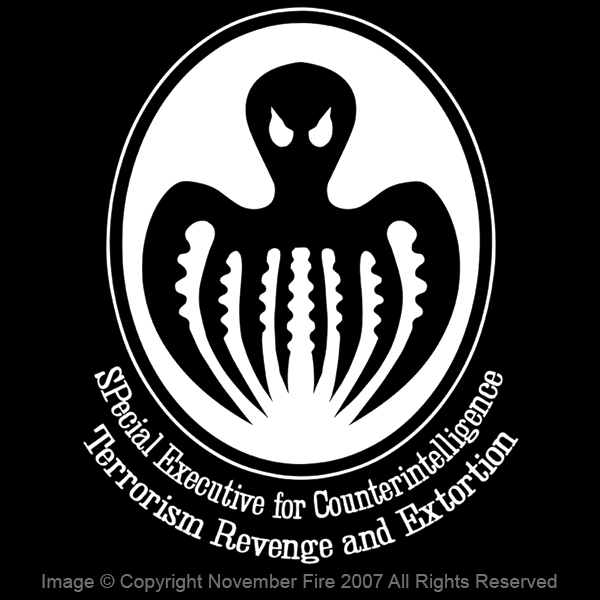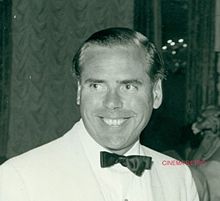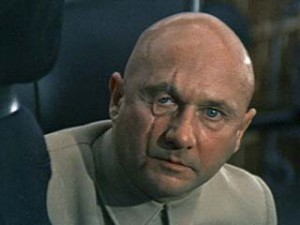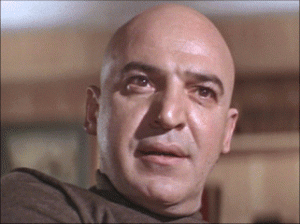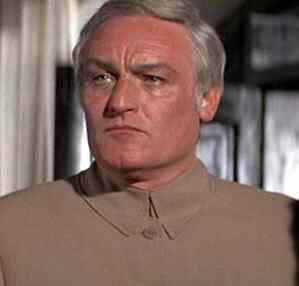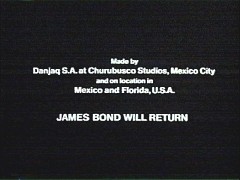McClory. Kevin McClory. For those who have not heard that name before, he is a bit of a legend among Bond fans. To EON, the production company behind the James Bond franchise, he was ironically their own personal Ernst Stavro Blofeld. A shadowy menace that would appear nearly every decade to threaten their world. EON has demonized McClory ever since the mid-1970s, but were they right to do so? That’s what I’m going to talk about today.
Before we get into the ring on this particular issue, we most first look back at what caused it. Ian Fleming wrote his first Bond novel, Casino Royale, in 1952. Ian always had designs on 007 making it onto film and during the following year, the novel was adapted as an episode of CBS’ anthology series Climax!. It starred Barry Nelson as an Americanized “Jimmy” Bond and Peter Lorre as the villainous Le Chiffre. It largely went unnoticed and CBS ultimately abandoned plans to do a Bond series, which Fleming had actually penned a few episodes for (and later turned into short stories). Ian didn’t give up though. During the late ’50s he approached Kevin McClory to aid in getting Bond onto the silver screen. McClory felt that none of Fleming’s six novels at the time were particularly suited for film and instead opted to create an original screenplay based around the character. Over the next few years, Fleming collaborated with Kevin McClory and screenwriter Jack Whittingham on various drafts. The project stalled over time and Fleming began to give up.
Now here’s where things get interesting. In 1961, Ian Fleming published Thunderball and was the sole credited author. Why is this a problem? Because he took everything that he had collaborated with McClory and Whittingham on and turned it into a novel without even giving the pair a story credit. I love you, Ian, but that was just plain moronic. Like any sensible person would, McClory and Whittingham filed suit and won. In addition to being paid damages and court costs, they were given a “based on a screen treatment by…” credit on any future publishing of the novel and also retained the film rights for it. Ian reportedly felt bullied and defeated, but from where I’m sitting he got what he deserved.
1962. Dr. No happens. Over the next two years, the Bond franchise catapults into fame with From Russia With Love and Goldfinger. In 1964, the producers decide…for whatever reason…that they want Thunderball to be the fourth James Bond adventure. They approach Kevin McClory and a deal is struck: McClory gets payment and the sole producer’s credit (with Broccoli & Saltzman credited as Executive Producers) and EON retains his rights for a decade. Thunderball is released the following year and, unadjusted, is still the highest-grossing entry in the franchise to date. Whatever their reason for choosing it was, it was absolutely the right decision to make.
So what did those rights entail? Ernst Stavro Blofeld and SPECTRE, among other things. Both were created by the Fleming-McClory-Whittingham trio almost a decade earlier and eventually found their way into multiple novels. In hindsight, it’s almost odd that McClory didn’t sue over their use in Dr. No and From Russia With Love. I’m sure he was well compensated in his deal with EON though. SPECTRE (and it’s leader, Blofeld) were the villains in all but one of the first seven James Bond films. Blofeld made his final “official” appearance* in the franchise in 1971’s Diamonds Are Forever. But why? Why wasn’t he ever used again? Well, he was supposed to be.
In the initial version of the Diamonds Are Forever script, the action does not stop at the oil rig extravaganza. Bond was to chase Blofeld back to the mainland and eventually battle him at a salt mine. They were to duke it out, with Bond knocking him into a grinder at the end of the battle. It would have been a fitting end to the man responsible for his wife’s death. For whatever reason, the producers decided to stop things at the oil rig battle and leave Ernst Stavro’s fate ambiguous. Did he die or secretly escape? The latter was the intended route and Blofeld was set to return in Roger Moore’s third film, The Spy Who Loved Me. They thought they had time to use him again before McClory regained their rights. They were wrong.
Roger Moore entered the franchise with 1973’s Live And Let Die and followed it up the very next year with The Man With The Golden Gun (1974). And here’s where the problems begin. Producer Harry Saltzman, for better or worse, was an entrepreneur who had very diverse interests. Unlucky for Harry, his dabbles outside of the Bond franchise had all but bankrupted him at this point and the banks finally came calling. The various court hearings and dealing unfortunately postponed work on The Spy Who Loved Me, which was originally intended as a 1975 release. Once the smoke cleared, Harry Saltzman was out and Albert “Cubby” Broccoli was left the sole guiding force of the franchise. Work resumed on TSWLM, but it was too late. 1975 had arrived and Kevin McClory had no intention of selling them the rights back. We could have been given a film that focused on avenging those that we love: Bond against Blofeld for Tracy’s death and Anya against Bond for Sergei’s. The latter subplot is still intact and Tracy’s death is mentioned, but the rest died when they were forced to change Blofeld into the Blofeld-like Karl Stromberg. Right now I’d like you to picture Bond coldly unloading his pistol into Blofeld at the end of the film. Feels good, doesn’t it? Alas, it was not meant to be. Still, feel free to watch it now and picture what should have been…
The fun doesn’t stop there though. Once McClory regained control of his rights, he immediately announced his intention to remake Thunderball and had none other than Sean Connery at his side! Sean had always had a rough relationship with EON on his last few films and his ties to McClory’s project always smacked of a giant public middle finger to Cubby & Harry. While EON and partners United Artists filed suit to stop Kevin’s plans, the courts ruled in favor of the latter. They merely delayed the inevitable. In 1983, finally got his way and Warner Bros. released Never Say Never Again, starring Connery. While still a box office success, it actually ended up grossing less than Roger Moore’s Octopussy, which was released the same year. It was Bond vs. Bond and EON came out on top.
Every once in awhile you’ll hear someone claim that it was McClory who was the cause for Timothy Dalton not getting a third crack at the role, but this isn’t true. United Artists, who had partial control of the Bond rights since Saltzman’s ousting, went tits up in the early ’90s. That alone was the cause of the constant delays on Bond 17 and by the time they were able to get things going again around late 1993, Dalton decided to move on. EON bought out the remainder of his contract and set their sights on Pierce Brosnan, who very nearly had the role back in 1987. The resulting film, GoldenEye (1995), was a hit and reintroduced the franchise to a new generation. It also got McClory’s attention.
In the mid-’90s, Kevin developed a partnership with Sony. The pairing announced that they would start a rival Bond FRANCHISE culled from McClory’s Thunderball rights and Sony’s own to Casino Royale. EON and MGM (who had purchased UA) filed legal action to prevent this from happening. Things were ultimately settled out of court in 1999 and Sony halted work on their would-be rival property. While they never actually made it to the casting stage, word has it that Liam “I have a certain set of skills”Neeson was the favorite for the role. McClory, undeterred, decided to mount on last attempt…albeit in a different way. With Sony backing him, he filed suit claiming that he was actually co-creator of the cinematic James Bond as we know him and vied for a chunk of the profit for ALL previous Bond films. The case was thrown out a year later on the grounds that McClory had simply waited too long to make such a claim.
In 2004, Sony bailed out a floundering MGM by purchasing 20% of the company. Despite this, EON was allowed to retain final say over the Bond franchise. They also finally gained the rights to Casino Royale, as well as Never Say Never Again. With Brosnan’s contract completed, the producers decided it was finally time to reboot the franchise from the ground-up, something that they had toyed with the notion of back in the late ’80s. Daniel Craig was cast and the first “official” adaptation of Casino Royale hit screens in 2006. Almost a week after the British premiere, Kevin McClory passed away.
While it has never been officially confirmed, EON seemingly once again controls the rights to Ernst Stavro Blofeld and SPECTRE. Will they ever reappear in the franchise again? It’s hard to say. The producers have stated on more than one occasion that they have no desire to remake any of the original Bond films for the new series, but they aren’t necessarily against reusing certain elements. Popular supporting character Q is finally making his return to the series this year in Skyfall and rumors still persist that we might have a Miss Moneypenny by the end of the film as well. With M, Felix Leiter, and Bill Tanner already in place in the new franchise, there really is nowhere else to expand in terms of the classic regulars outside of villains themselves.
Before any of you get too excited at the prospect of seeing old favorites in a new fashion, I’d like to add that I find it highly unlikely that it will happen during Daniel Craig’s tenure as Bond. Craig is set for two more films, with Bond 24 already in pre-production and marching towards a 2014 release. If Blofeld or anyone else rears their head again, it probably won’t be until we have a new leading man. The Bond series has always been in flux in terms of tone. Connery’s run started out serious and slowly become more outlandish as it went on. Lazenby’s solo effort brought things back down to Earth, only for Connery’s last hurrah to return them to a bit of extravagance. Despite the overall reputation of his tenure, even Moore’s run started out mostly low key before moving onto the wonderful ridiculousness of Moonraker, his fourth outing. Dalton’s duology again opted for a more grounded, grittier Bond and Brosnan’s era returned things to the more bombastic style. Are we seeing the pattern here? While I could be wrong in the end, don’t be too shocked if Bond 26 (and Craig’s replacement) begins the slow return to the franchise’s more over-the-top tendencies. And while you might not feel that way right now, I suspect many of us might be ready for it to do so again by then.
Was Kevin McClory the megalomaniac that EON has made him out to be over the years. Of course not. In most cases, the man took a stand for what was rightfully his and should be respected for doing so. Did he make the right decisions in the end? In the ’60s? Yes. The ’70s and beyond? I don’t think so. The logical and more lucrative thing to do would have been to sell or at least loan his rights to EON again once 1975 rolled around. While he likely wouldn’t have gotten a big Never Say Never Again-style payday upfront, I think he would have made more money in the long run. Even if they had killed Blofeld in 1977, it’s unlikely that SPECTRE would have gone unused in the years between then and 2002. Whether Ernst Stavro Blofeld, SPECTRE, and any number of other classic characters ever reappear in 007’s silver screen future again, it’s nice to know that everything Bond was finally reunited under one roof in the end. And, as always…
* – Is the wheelchair-bound, neckbraced bald villain who attacks Bond at start of For Your Eyes Only (1981) Ernst Stavro Blofeld? Of course he fucking is. Sadly, they decided to end this last appearance with him comically being tossed down a smokestack set to a slidewhistle-esque noise in a very Pink Panther fashion. Was having an opening sequence of Bond visiting his wife’s grave only to be kidnapped by an uncredited Blofeld a good idea? Absolutely. But the way in which they executed it was not only a middle finger to Kevin McClory, but to the fans as well. Ernst Stavro Blofeld deserved better and so did we.
